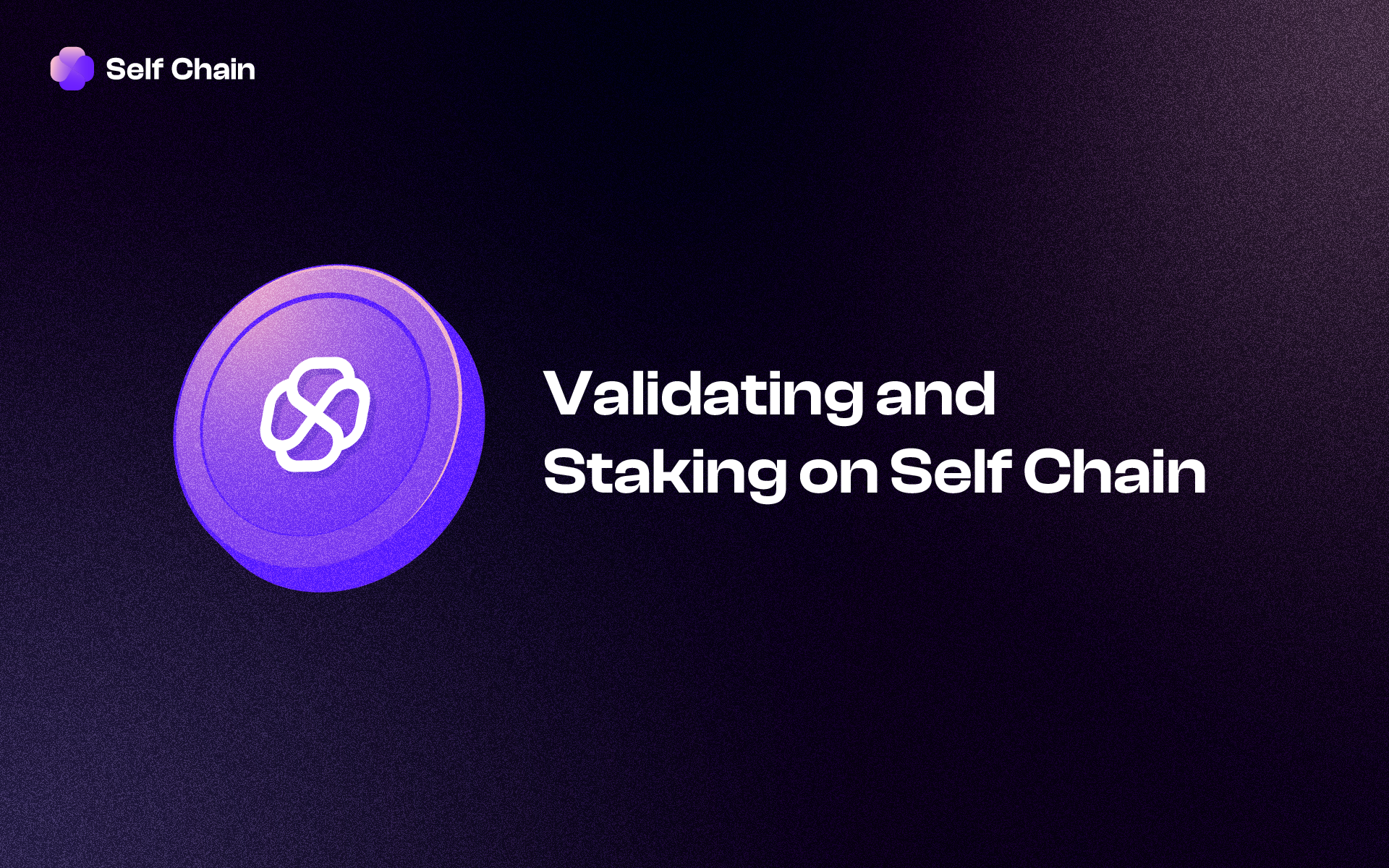Validating And Staking On Self Chain: A Comprehensive Guide to Validator Participation
Empower the Self Chain network as a validator: Stake, secure, and earn rewards.

Self Chain, built on the Cosmos ecosystem, utilizes Proof of Stake (PoS) consensus to offer an exciting opportunity for $SLF holders. By becoming a validator on Self Chain, individuals can actively participate in securing the network, engaging in delegated governance, and receiving rewards. This article serves as a comprehensive guide for individuals interested in becoming validators on Self Chain, providing detailed steps and insights into the process.
Self Chain and Proof of Stake:
Self Chain is an innovative blockchain project built on the Cosmos ecosystem. Leveraging Proof of Stake (PoS) as its consensus mechanism, Self Chain ensures efficient and secure transaction validation while minimizing energy consumption. PoS allows validators to secure the network based on their stake in $SLF tokens, promoting decentralization and sustainability.
Becoming a Self Chain Validator:
Becoming a validator on Self Chain involves a series of steps designed to ensure the network's security and reliability. The following is a detailed overview of the process:
a) Setting up a Validator Node:
Validators must establish a validator node, which serves as their point of presence on the Self Chain network. This entails setting up the necessary infrastructure, including secure servers, reliable internet connectivity, and adequate storage capacity.
b) Acquiring and Bonding $SLF Tokens:
To become a validator, individuals must acquire a sufficient number of $SLF tokens and bond them to their validator account. Bonding tokens showcases a commitment to the network and acts as collateral, reinforcing the validator's integrity.
c) Network Connectivity and Configuration:
Validators need to ensure stable network connectivity and configure their validator node according to the Self Chain specifications. This involves setting up firewalls, security measures, and maintaining up-to-date software.
d) Participating in Consensus and Block Validation:
Once the validator node is operational, validators actively participate in the consensus process. They propose blocks and validate transactions to maintain network security and confirm the integrity of data. Validators contribute to the decentralization and overall efficiency of Self Chain.
Staking Benefits and Costs:
Staking $SLF tokens as a validator on Self Chain offers numerous benefits and considerations:
a) Network Security: Validators play a crucial role in securing the Self Chain network, ensuring transaction authenticity and preventing malicious activities.
b) Delegated Governance: Validators actively participate in delegated governance, influencing important decisions that shape the future of Self Chain. They can vote on proposals, network upgrades, and consensus parameters, actively contributing to the ecosystem's growth.
c) Rewards and Fees: Validators receive staking rewards and transaction fees for their active participation in block validation. These rewards incentivize validators to act in the best interest of the network and further secure the ecosystem.
It's important to be aware of the following considerations:
a) Slash Risk: Validators should adhere to the network's rules and guidelines to avoid penalties or slashing, which may lead to a reduction in bonded tokens. Validators must act responsibly to maintain their reputation and rewards.
b) Operational Expenses: Running a validator node requires technical expertise, ongoing maintenance, and reliable network connectivity. Validators must consider the associated costs and commit to providing a reliable and secure network infrastructure.
Conclusion and Additional Resources:
Staking/Delegating $SLF tokens as/to a validator on Self Chain offers a unique opportunity to actively contribute to the network's security, participate in governance decisions, and earn rewards. By following the steps outlined in this guide, you can embark on your journey as a validator on Self Chain.
For more detailed instructions and guidelines, visit the official Self Chain staking site. Additionally, refer to the Self Chain staking guide for a step-by-step tutorial on becoming a validator. Join the Self Chain community and play a pivotal role in the growth and success of this innovative blockchain project.
Official Self Chain Staking Site: [ https://staking.selfchain.xyz/ ]
Self Chain Staking Guide: [ https://docs.selfchain.xyz/usdself-staking-and-delegation ]
Set up a Validator Guide: [https://docs.selfchain.xyz/usdself-staking-and-delegation/set-up-a-self-chain-validator ]
About Self Chain
Welcome to Self Chain, a Layer 1 blockchain designed for trustless, next-generation key management. Self Chain offers a secure infrastructure for keyless wallets and ensures enhanced security and user control through advanced technologies like Multi-Party Computation (MPC) and Threshold Signature Scheme (TSS).
Join us as we shape the future of finance, privacy, and digital ownership. Unlock the true potential of blockchain technology with Self Chain and be part of the decentralized movement.
